Related Research Articles

General Edmund Kirby Smith was a senior officer of the Confederate States Army who commanded the Trans-Mississippi Department from 1863 to 1865. Prior to the American Civil War, Smith served as an officer of the United States Army.

John Buchanan Floyd was the 31st Governor of Virginia, U.S. Secretary of War, and the Confederate general in the American Civil War who lost the crucial Battle of Fort Donelson.
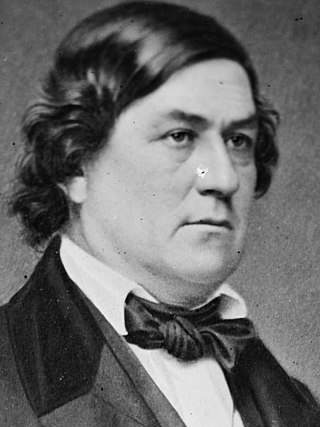
Robert Mercer Taliaferro Hunter was an American lawyer, politician and planter. He was a U.S. representative, speaker of the House (1839–1841), and U.S. senator (1847–1861). During the American Civil War, Hunter became the Confederate States Secretary of State (1861–1862) and then a Confederate senator (1862–1865) and critic of President Jefferson Davis. After the war, Hunter failed to win re-election to the U.S. Senate, but did serve as the treasurer of Virginia (1874–1880) before retiring to his farm. After fellow Democrat Grover Cleveland was elected President of the United States in 1884, Hunter became the customs collector for the port of Tappahannock until his death.

The Battle of Appomattox Court House, fought in Appomattox County, Virginia, on the morning of April 9, 1865, was one of the last battles of the American Civil War (1861–1865). It was the final engagement of Confederate General in Chief, Robert E. Lee, and his Army of Northern Virginia before they surrendered to the Union Army of the Potomac under the Commanding General of the United States Army, Ulysses S. Grant.

William Henry Fitzhugh Lee, known as Rooney Lee or W. H. F. Lee, was the second son of General Robert E. Lee and Mary Anna Custis. He was a planter, a Confederate cavalry General in the American Civil War, and later a Democratic Congressman from Virginia.

William Edmondson "Grumble" Jones was a Confederate cavalry general with a reputation for being a martinet to his troopers and fractious toward superiors, but acknowledged to be a good commander. After disagreements of a personal nature with J.E.B. Stuart, Jones's brigade was set to guarding supply lines and unavailable during a crucial juncture of the Gettysburg Campaign when Lee suffered from a lack of capable reconnaissance cavalry. As the personality clash between Jones and Stuart escalated, Jones faced charges for impertinence, and was transferred to separate him from Stuart. Jones was killed leading a counter-attack in the 1864 Battle of Piedmont.

Samuel Cooper was a career United States Army staff officer, serving during the Second Seminole War and the Mexican–American War. Although little-known today, Cooper was technically the highest-ranking general officer in the Confederate States Army throughout the American Civil War, even outranking Robert E. Lee. After the conflict, Cooper remained in Virginia as a farmer.

Thomas Taylor Munford was an American farmer, iron, steel and mining company executive and Confederate colonel and acting brigadier general during the American Civil War.
The Battle of Marion was a military engagement fought between units of the Union Army and the Confederate Army during the American Civil War near the town of Marion, Virginia. The battle was part of Union Maj. Gen. George Stoneman's attack upon southwest Virginia, aimed at destroying Confederate industrial infrastructure near Saltville and Marion. Union Cavalry and Infantry regiments—some 4,500 soldiers in total—left Tennessee on December 17 for southwestern Virginia.
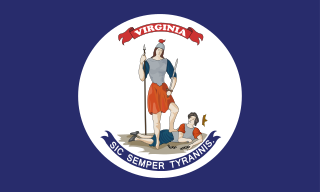
The 64th Virginia Mounted Infantry Regiment was formed from troops raised in Lee, Scott, Wise and Buchanan counties in Virginia for service in the Confederate States Army during the American Civil War. It served as an infantry regiment, a cavalry regiment, and a mounted infantry (dragoon) unit, and had a mixed reputation.
Henry Brainerd McClellan was an officer and adjutant general in the Confederate States Army during the American Civil War, a teacher and author. He was a professor at Sayre Female Institute in Lexington, Kentucky for 35 years after the war.
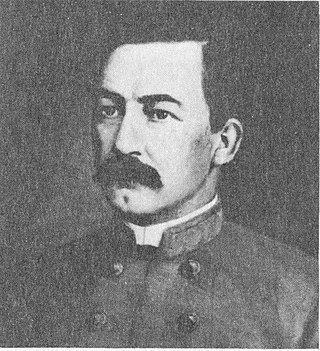
Israel Greene was a member of the United States Marine Corps and the leader of the company of Marines that captured John Brown during his raid on Harpers Ferry. He later left the USMC and served as an officer in the Confederate States Marine Corps during the American Civil War.
Eliphalet Frazer Andrews, an American painter known primarily as a portraitist, established an art instruction curriculum at the behest of William Wilson Corcoran at his Corcoran School of Art, and served as its director, 1877–1902. He received many commissions to create both original portraits and copies of images of deceased famous Americans, which are displayed by federal, state, and local institutions. His art is housed at the Smithsonian American Art Museum, the Ohio State Capitol, and numerous paintings at The White House and the United States Capitol.

Alexander W. Monroe was a prominent American lawyer, politician, and military officer in the U.S. states of Virginia and West Virginia. Monroe served as a member of the Virginia House of Delegates and West Virginia House of Delegates representing Hampshire County. He was the Speaker of the West Virginia House of Delegates during the 1875–1877 legislative session. Monroe also represented Hampshire County in the West Virginia Constitutional Convention of 1872.

The 5th New York Cavalry Regiment, also known as the 5th Regiment New York Volunteer Cavalry and nicknamed the "1st Ira Harris Guards", was a cavalry regiment of the Union Army during the American Civil War. The regiment had a good fighting reputation, and had important roles in the Battle of Hanover and the Battle of the Wilderness. It was present at nearly 175 battles and skirmishes, including Gettysburg, Opequon, and Cedar Creek. A majority of its fighting was in Virginia.

The 6th New York Cavalry Regiment, also known as the 6th Regiment New York Volunteer Cavalry and nicknamed the "2nd Ira Harris Guards", was a cavalry regiment of the Union Army during the American Civil War. The majority of its fighting was in Virginia as part of the Army of the Potomac.
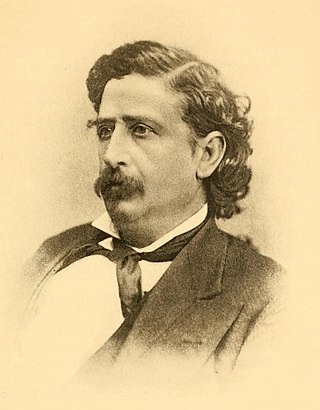
Edwin Warren Moïse was a Jewish-American lawyer, Confederate officer, and Adjutant-General from South Carolina.
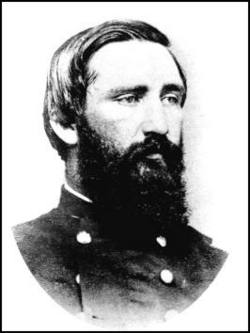
Sanders' Knoxville Raid saw 1,500 Union cavalry and mounted infantry led by Colonel William P. Sanders raid East Tennessee before the Knoxville campaign during the American Civil War. The successful raid began at Mount Vernon, Kentucky and moved south, passing near Kingston, Tennessee. Moving east from the Kingston area, the raiders struck the East Tennessee and Georgia Railroad at Lenoir Station. The Union horsemen rode northeast along the railroad, destroying track, bridges, and property useful to the Confederate States of America. Blocked from seizing Knoxville by its 1,000 Confederate defenders, Sanders' horsemen destroyed a major bridge across the Holston River at Strawberry Plains on the East Tennessee and Virginia Railroad. After wrecking a smaller bridge at Mossy Creek, the raiders turned northwest, evading pursuers by slipping through an obscure gap in the Cumberland Plateau. Sanders' men reached Boston, Kentucky on June 24, having captured and paroled over 400 Confederate soldiers while sustaining minimal losses in men but considerable losses in horses.

Daniel Henry Rucker was a career officer in the United States Army. He was commissioned in 1837 and served for nearly 45 years, including during the American Indian Wars, Mexican–American War, and American Civil War. He attained the rank of brigadier general and was most notable for his service as Assistant Quartermaster General of the United States Army, then Quartermaster General. Rucker received brevet promotions to major general of United States Volunteers and major general in the Regular Army in commendation of his Civil War service. Rucker was the father-in-law of General Philip Sheridan.
References
- 1 2 Ratliff, Larry; Hockett, Jack; Ratliff, Gerald; Ratliff, Grace Addison (November 16, 1998). Some Descendants of John Ratliff & Charlotte White, 1765-1997. Heritage Books. ISBN 9780788408649 – via Google Books.
- ↑ "Holston Pastfinder". Holston Territory Genealogical Society. November 16, 2000 – via Google Books.
- ↑ Virginia (November 16, 1918). "Annual Reports of Officers, Boards and Institutions of the Commonwealth of Virginia" – via Google Books.
- ↑ "House History". history.house.virginia.gov.
- ↑ Brock, Robert Alonzo (November 16, 1888). "Virginia and Virginians: Eminent Virginians : Executives of the Colony of Virginia, from Sir Thomas Smyth to Lord Dunmore :executives of the State of Virginia, from Patrick Henry to Fitzhugh Lee : Sketches of Gens. Ambrose Powel Hill, Robert E. Lee, Thos. Jonathan Jackson, Commodore Maury". H.H. Hardesty – via Google Books.
- ↑ Harman, John Newton (November 16, 1922). Annals of Tazewell County, Virginia from 1800 to 1922. W.C. Hill Printing Company. ISBN 9780598471109 – via Google Books.
- ↑ http://www.researchonline.net/vacw/unit22.htm
- ↑ "10th Kentucky Cavalry, CSA Roster". sites.rootsweb.com.
- ↑ Office, Kentucky Adjutant-General's (November 16, 1980). "Report of the Adjutant General of the State of Kentucky: Confederate Kentucky Volunteers, War 1861-65". Cook & McDowell – via Google Books.